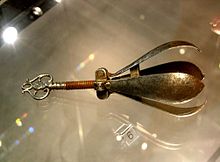- Choke pear (torture)
-
The choke pear (or pear of anguish) is the modern name for a type of instrument displayed in some museums, consisting of a metal body (usually pear-shaped) divided into spoon-like segments that could be spread apart by turning a screw. The museum descriptions and some recent sources assert that the devices were used either as a gag, to prevent people from speaking, or as an instrument of torture. The instrument was inserted into the victim's mouth, and then slowly spread apart as the screw was turned.
Contents
Origins
There is no contemporary first-hand account of those devices or their use. An early mention is in F. de Calvi's L'Inventaire général de l'histoire des larrons ("General inventory of the history of thieves"), written in 1639, which attributes the invention to a robber named Capitaine Gaucherou de Palioly in the days of Henry of Navarre. Palioly would have used a mechanical gag to subdue a wealthy Parisian while he and his accomplices robbed the victim's home.[1][2]
Further mentions of the device appear in the 19th century. They are also mentioned in Grose's Dictionary of the Vulgar Tongue (1811) as "Choak Pears," and described as being "formerly used in Holland."[3]
They were also discussed in a book by Eldridge and Watts, superintendent of police and chief inspector of the detective bureau in Boston, Massachusetts (1897). While accepting that ordinary pear-shaped gags exist, they observed that contemporary robbers used no such device as Palioly's Pear and cast doubt upon its very existence in the first place, saying that "fortunately for us this 'diabolical invention' appears to be one of the lost arts, if, indeed, it ever existed outside of de Calvi's head. There is no doubt, however, of the fashioning of a pear-shaped gag which has been largely used in former days by robbers in Europe, and may still be employed to some extent. This is also known as the 'choke-pear', though it is far less marvellous and dangerous than the pear of Palioly."[4]
Another mention is found in Brewer's Dictionary of Phrase and Fable (1898) claims that "Robbers in Holland at one time made use of a piece of iron in the shape of a pear, which they forced into the mouth of their victim. On turning a key, a number of springs thrust forth points of iron in all directions, so that the instrument of torture could never be taken out except by means of the key."[5]
Museum pieces
Though there is little or no evidence of its being used by bandits, there are a number of extant examples of ornate and elaborate, pear-shaped devices with three or four leaves or lobes, driven by turning a key that rotates the central screw thread, which spreads the leaves. These are generally held in museums devoted to the subject of torture, and are described as instruments of torture by distension or evisceration. Some, but not all, have small spikes of uncertain purpose at the bottom of each leaf. However, these devices do not seem to match the descriptions given by Calvi or the 19th century sources.
This version of the pear has also been referred to as the "Pear of Confession", the "Pope's Pear" (these due to reports that such devices were used during the Inquisition); the "oral pear", "vaginal pear", or "anal pear"; and just "The Pear".
See also
- Choke pear (plant), a hard-to-swallow fruit that may have been the origin of the instrument's name.
References
- ^ "La redoutable poire d'angoisse/Une expédition du voleur Palioli" (in French). La France pittoresque (21). Winter 2006–2007. http://www.magazine-histoire.com/numeros/26b.htm.
- ^ marquis de Adolphe Chesnel (1856) (in French). Dictionnaire des superstitions, erreurs, préjugés et traditions populaires. Paris: Migne. pp. 915–916.
- ^ Francis Grose (1811). Dictionary of the Vulgar Tongue; a.k.a. Lexicon Balatronicum, A Dictionary of Buckish Slang, University Wit and Pickpocket Eloquence. Pall-Mall, London. http://www.fromoldbooks.org/Grose-VulgarTongue/.
- ^ Benjamin P. Eldridge and William B. Watts (1897/2004). Our Rival, the Rascal: A Faithful Portrayal of the Conflict Between the Criminals of This Age and The Police. Kessinger Publishing. pp. 285–286. ISBN 1417959525.
- ^ "Choke-pear". Brewer's Dictionary of Phrase and Fable. Bartleby.com. 1898. http://www.bartleby.com/81/3513.html.
Categories:- Medieval instruments of torture
- Modern instruments of torture
- European instruments of torture
Wikimedia Foundation. 2010.


